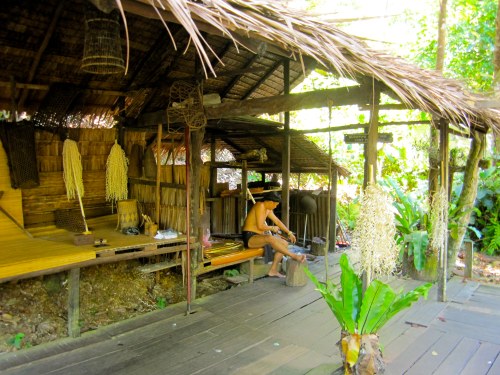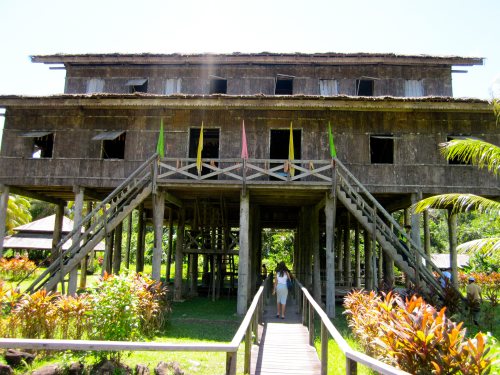Sarawak tribes and orang-utans of Borneo
We were amazed at our recent visit to the Sarawak Cultural Village and Semenggoh Orang Utan Sanctuary near Kuching. An eye-opener of what’s truly amazing about Borneo Sarawak, that is irresistible!
Located near the Mount Santubong and facing the South China Sea, the Sarawak Cultural Village is also the place for the Borneo Rainforest Music Festival in July. Like a “living museum”, they portray the various ethnic tribes in the Borneo state of Sarawak and its rich cultural diversity: bridges in the traditional way
bridges in the traditional way
Bidayuh:
The Bidayuh (8.4% of Sarawak’s population) – nicknamed by early Europeans as “Land Dayaks” - live mainly in the catchment of the Sarawak and Sadong rivers. They built their houses in mountain fastnesses, tacked to a steep hillside like a huge staircase. This was partly for protection against enemies, partly for access to fresh water.
Iban:
The Iban, once known as “sea dayaks” (one-third of Sarawak’s population) built their longhouses to last 20 years or until the farmland was exhausted. Many families live together in a single longhouse. The traditional longhouse is made of timber tied with creeper fibre, roofed with leaf thatch, built beside the river.
 Communal living in an Iban longhouse
Communal living in an Iban longhouse
Penan:
The shy nomadic people of the jungle, the Penans, live in the dense virgin jungles of Central Borneo. Penan shelters are quickly constructed to last a few weeks or months. Penans are also known to make the blowpipes with poison darts (from the sap of the upas tree) for hunting in the jungles.
 A Penan in his hut making a blowpipe
A Penan in his hut making a blowpipe
Orang Ulu:
Orang Ulu, “up-river dwellers” is used to describe the people living in Central Borneo along the upper reaches of Sarawak’s rivers, and they account for about 5.5% of Sarawak’s population comprising of the Penan, the Kayan and Kenyah. In the past, Orang Ulu were famous as sword-smiths. Traditionally they built their longhouse to last.
Melanau:
The Melanau people (5.8% of Sarawak’s population) used to traditionally live near the sea within reach of the pirates. The Melanau built massive houses 40 feet above the ground. They also differ from most other Borneo people in that they prefer to eat sago rather than rice.
Then we headed to the famous Semenggoh Orang Utan Sanctuary - located 20 km away from Kuching – a safe haven for the Orang-Utan, an endangered species and Southeast Asia’s lone great ape genus. These gentle and shy creatures spend most of their time foraging for food among the trees in private but they’ve learnt to come out of hiding during the park’s regular feeding schedule. Did you know that the word “orang-utan” is derived from the Malay language meaning Man of the Jungle?
This was an incredible discovery for us and I’m proud we have something so amazing here in Malaysia!
source: http://frogandprincess.wordpress.com/2010/06/25/sarawak-tribes-and-orang-utans-of-borneo/


















No comments:
Post a Comment